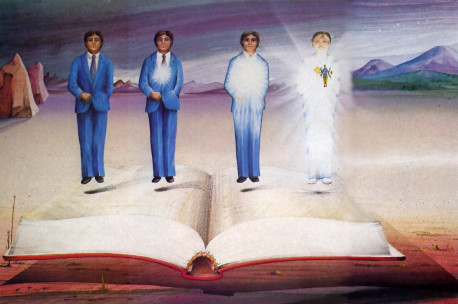I can see my body, and in a way I can see my mind and intelligence. Now then, what about the “I” who’s doing all this seeing? Can I see the “I”?
by Amogha Dasa
As we all know, the organ for seeing is the eye. The eye catches the light rays reflected by whatever is around us and focuses these rays on its retina. Then it sends images to the brain via the optic nerves. And that, pretty much, is how we see things.
Of course, there are some things we can’t see with our unaided eyes. Some things are too small, so we have to use a microscope. Other thirds are too far away so we have to use a telescope. Still other things (like ultraviolet, infrared, or television waves) are too subtle, but we can see them if we have the right instruments.
So despite our limited seeing power, in one way or another we can perceive the world’s gross and subtle elements. Ancient India’s Vedic literatures catalog these elements for us as solid matter, liquid, radiant energy, gas, ether, mind, intelligence, and ego. Each element is progressively subtler. Liquid is subtler than solid matter, radiant energy subtler than liquid, gas subtler than radiant energy, and so on. We can see solid matter, of course, and liquid and radiant energy as well, but we can’t see gas or ether. Yet we can perceive gas in inflated balloons and ether in radio and television transmissions. Then, too, we can’t see the subtler elements mind and intelligence. Yet we can perceive mind in thought patterns and intelligence in astute judgments.
Now then, just who or what is doing all this perceiving?
You are—the living soul within your body. All of us are spiritual souls-subtler than the subtlest material element. Naturally we can’t see the soul with our gross material eyes. But just because we can’t see it, that doesn’t mean it doesn’t exist. If someone argued, “I can’t see the atom, so I don’t think it exists,” that wouldn’t sway anyone who knew how tiny the atom actually is.
And the soul is tinier than the atom. As the Vedic literatures inform us, its size is one ten-thousandth the tip of a hair. No wonder we can’t see the soul. Yet there is a way to perceive it. Just as a physicist perceives the atom through a certain process, so we can perceive the soul through the process of transcendental knowledge. And what is transcendental knowledge? Lord Krsna says in Bhagavad-gita that transcendental knowledge means understanding the difference between the soul and matter.
As Krsna explains, the soul is conscious but matter is unconscious. Each of us can understand that “I am a conscious living being,” yet if any part of our body were amputated, that part would not be conscious. So we can understand that the body itself has no consciousness; it gets its consciousness from the soul. Nor can we generate consciousness by combining unconscious elements. Consciousness is the symptom of the soul, and the soul is the subtlest of the elements.
Krsna also points out that the soul stays the same but matter changes: “As the embodied soul continually passes from boyhood to youth and from youth to old age, the soul similarly passes into another body at death. The self-realized soul is not bewildered by such a change.” (Bg. 2.13) Now that I’m a young man, I can remember when I was a small boy and when I was a teenager. And when I’m an old man, I’ll remember when I was a middle-aged man. My material body is constantly changing. But somehow I’m still the same person—so I see that I am not the body but the soul within the body. And after I’ve passed away, the body will go right on changing, but I—the soul—will remain the same. As Lord Krsna explains, a person who has transcendental knowledge is not at all puzzled by this transmigration of the soul. Because he has perfect knowledge of the soul and matter and the difference between them, he sees everything perfectly.
Even a person who just has material knowledge can see better than someone whose eyes are clouded over by ignorance. For instance, when a watchmaker looks inside your watch, he can see what’s wrong with it. But you can’t see, because you don’t have the knowledge. A harbor pilot looks at the harbor, and you look at the harbor. But the pilot knows how to take the ship into the harbor safely; you don’t. Both of you are looking at the harbor, but one has knowledge and the other doesn’t. So the one who has knowledge can actually see. We have to learn from a person who has knowledge if we want to expand our vision and see perfectly.
One morning in Perth, Australia, His Divine Grace A.C. Bhaktivedanta Swami Prabhupada was walking along the beach. “You want to judge everything by what you can see with your eyes,” he said. “But can you see India? I have just come from India. It is across this ocean, but you cannot see it. Does that mean there is no India? No. If you want knowledge, you have to learn from someone who has already seen.”
Bhagavad-gita puts it very simply: “Just try to learn the truth by approaching a bona fide spiritual master. Inquire from him submissively and render service unto him. The spiritual master can impart transcendental knowledge unto you because he has seen the truth.” In Bhagavad-gita As It Is, Srila Prabhupada shows us how to gain transcendental knowledge and see the soul perfectly. Just as we can see microbes through a microscope and stars through a telescope, so we can see the soul through Bhagavad-gita—the “soul scope.”


Leave a Reply